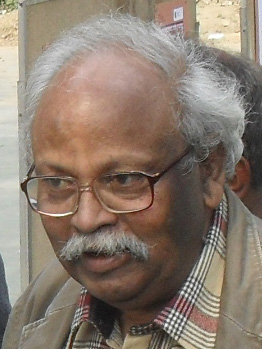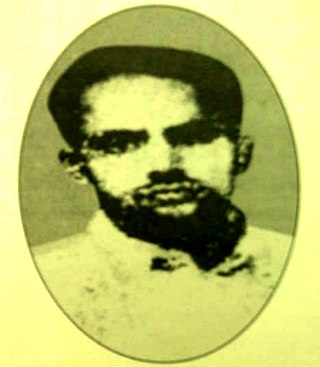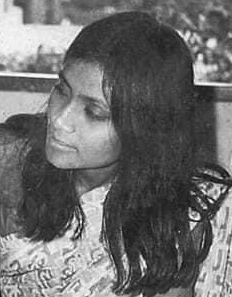
Mahbubul Haque Khan, known as Azam Khan, was a Bangladeshi singer-songwriter, record producer, and lead singer for the pop-rock band Uccharon. He was also a freedom fighter who took part in the Liberation War of Bangladesh in 1971. He is considered to be one of the greatest artists in the history of Bangladeshi folk music and a founding figure of Bangla rock.

The Bangla Academy is the official regulatory body of the Bengali language in Bangladesh. It is an autonomous institution funded by the Government of Bangladesh that fosters the Bengali language, literature and culture, works to develop and implement national language policy and conducts original research in Bengali. Established in 1955, it is located in the Burdwan House in Shahbagh, Dhaka, within the grounds of the University of Dhaka and Suhrawardy Udyan. The Bangla Academy hosts the annual Ekushey Book Fair.

Zainul Abedin, also known as Shilpacharya was a Bangladeshi painter. He became well known in 1944 through his series of paintings depicting some of the great famines in Bengal during its British colonial period. After the Partition of Indian subcontinent he moved to East Pakistan. In 1948, he helped to establish the Institute of Arts and Crafts at the University of Dhaka. The Indian Express has described him as a legendary Bangladeshi painter and activist. Like many of his contemporaries, his paintings on the Bengal famine of 1943 are viewed as his most characteristic works. His homeland honored him with the title "Shilpacharya" "Great teacher of the arts" for his artistic and visionary attributes. He was the pioneer of the modern art movement that took place in Bangladesh and was rightly considered by Syed Manzoorul Islam as the founding father of Bangladeshi modern arts, soon after Bangladesh earned the status of an independent republic.

Rafiqun Nabi, better known as Ranabi, is a Bangladeshi artist and cartoonist. He is best known for creating Tokai, a character symbolizing the poor street boys of Dhaka who lives on picking things from dustbins or begging and having a knack of telling simple yet painful truths about current political and socio-economic situation of the country. He was awarded Ekushey Padak in 1993 by the government of Bangladesh.

Shafiur Rahman is considered in Bangladesh to be a martyr of the language movement which took place in the former East Pakistan.

Ekushey Padak is the second highest civilian award in Bangladesh, introduced in memory of the martyrs of the Bengali Language Movement of 1952. The award is given to recognize contributions in a number of fields, including culture, education, and economics. The Ministry of Cultural Affairs administers the award.
Abu Naser Muhammad Gaziul Haque was a language activist and an activist leader during the Bengali Language Movement.

Syed Jahangir was a Bangladeshi painter. He was awarded Ekushey Padak by the Government of Bangladesh in 1985. He served as the department head of the Arts Faculty at Shilpakala Academy in 1977. His notable paintings include Attmar Ujjibon, Ullas, Dhoni, Ojana-Oneshya and Osoni-Sangket.

Safiuddin Ahmed was a Bangladeshi artist. He was awarded Ekushey Padak in 1978 and Independence Day Award in 1996 by the Government of Bangladesh.

Mustafa Monwar is a Bangladeshi artist. He is a painter, sculptor, radio performer and professor of fine arts. He was awarded Ekushey Padak in 2004 by the Government of Bangladesh.

Mohammad Kibria was a Bangladeshi artist. He was awarded Ekushey Padak in 1983 and Independence Day Award in 1999 by the Government of Bangladesh.

Murtaja Baseer was a Bangladeshi painter and artist known for his abstract realism themed works. He was also a poet, author, researcher, numismatist, and filmmaker. Baseer was awarded the Ekushey Padak, Bangladesh's second highest civilian honor, in 1980, and the Swadhinata Padak, or Independence Day Award, Bangladesh's highest state award, in 2019.

Qayyum Chowdhury was a Bangladeshi painter. Along with Zainul Abedin, Quamrul Hassan and Safiuddin Ahmed, he is considered as a first generation artist of Bangladesh. He was awarded the Ekushey Padak in 1984 and the Independence Day Award in 2014 by the Government of Bangladesh.
Aminul Islam was a Bangladeshi artist. He was a part of Bangladesh modern art movement in 1950s. He was awarded Ekushey Padak in 1981 and Independence Day Award in 1988 by the Government of Bangladesh.

Shamim Sikder was a Bangladeshi sculptor. Sikder served as a professor at the Faculty of Fine Arts, University of Dhaka between 1980–2001. She was awarded the Ekushey Padak in 2000 by the Government of Bangladesh.
Keramat Moula is a Bangladeshi theater activist and art director. He was awarded Ekushey Padak in 2014 by the Government of Bangladesh.
S. M. Mohsin was a Bangladeshi stage and television actor. He became an honorary fellow of the Bangla Academy in 2018. In 2020, he was awarded Ekushey Padak by the Government of Bangladesh for his contribution to acting.
Sayeba Akhter is a Bangladeshi physician who has dedicated her career to eliminating obstetric fistula. She is an executive member of the International Society of Obstetric Fistula Surgeons and has previously served as the president of the Obstetrics and Gynaecology Society of Bangladesh. She leads two charities, in Dhaka and Gaibandha, which focus on the education of underprivileged girls.
Sheikh Md Monirul Islam is a retired major general of the Bangladesh Army and chief external & corporate affairs officer of bKash Limited.












